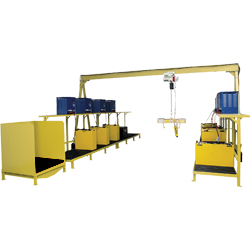We use cookies to make your experience better. To comply with the new e-Privacy directive, we need to ask for your consent to set the cookies. Learn more.
How Warehouse Signage Can Improve Efficiency
As every warehouse manager knows, small gains in efficiency can turn into substantial profits down the line. Signage, labels, and floor markings are essential components of a safe warehouse, but they can also provide increased productivity by keeping employees engaged in their work.
Here are a few ways you can use signage to help reach your efficiency goals:
Focus on Safety
In 2013, nearly one out of every 50 workers in U.S. warehouses sustained injuries that required days away from work, according to the Bureau of Labor Statistics. Injuries can significantly decrease efficiency, since new workers need to be brought in and trained.
Reduce injuries with safety signs across your entire facility. OSHA standard 1910.145 instructs employers to warn their staff about both potential hazards and specific safety threats with clear, recognizable signs.
In addition to pointing out hazards, signs can help workers locate safety equipment with a quick glance, improving response times and preventing the most severe accidents. These features are particularly important in the battery room; a comprehensive signage and posting kit will provide all the signs and labels you need to maintain safety and efficiency in battery charging areas.

Separate Underperforming Equipment
Broken or damaged equipment isn’t just a safety hazard, it’s a threat to productivity. Clearly label equipment that needs service or repair. Lift trucks that need repair should also be stored in a designated part of your facility until they’re ready to rejoin the fleet.
If you find that you’re regularly running at partial capacity, you may need to invest in new lift trucks or review your battery fleet management practices. Remember, regular maintenance can be time consuming in the short term, but it’s well worth the investment over time.
Prevent Damage to Material Handling Devices
Warehouses can't function without a full fleet of lift trucks, forklift battery changers, gantry cranes and other material handling equipment. Protect valuable equipment from forklift strikes by designating forklift traffic lanes with bright vinyl floor tape, and post signs indicating forklift traffic areas.
Labeling on all material handling devices can prevent equipment damage due to accidental misuse, as well. OSHA standard 1910.178(a) requires forklifts to display labels proving that they passed safety tests, as well as listing any modifications that change operation or safe limits.
Supplement Staff Training
Signs and posters can enhance training programs, helping to keep staff safe and productive. Posters detailing ergonomic lifting techniques and material handling methods provide useful reminders weeks and months after an initial training session.
Signs are such a staple of the workplace that it's easy to overlook their importance. However, when staff read, understand, and comply with the messages on safety signs, these postings make a huge contribution to warehouse safety, and in material handling industries, safety and productivity are closely related. Proper signage also encourages smart work habits and can even improve ergonomics — not bad for a relatively meager investment.
References:
"About the Warehousing and Storage Subsector." U.S. Bureau of Labor Statistics. United States Department of Labor, n.d. Web. 16 July 2015.
Hodkiewicz, Tricia S. "Warehouses store many hazards: stock up on safety sign and marking ideas." Industrial Safety & Hygiene News 2012: 108. General OneFile. Web. 16 July 2015.
“Powered industrial trucks. - 1910.178.” Occupational Safety and Health Administration, United States Department of Labor, n.d. Web. 16 July 2015.
"Specifications for Accident Prevention Signs and Tags. - 1910.145." Occupational Safety and Health Administration. United States Department of Labor, n.d. Web. 16 July 2015.
